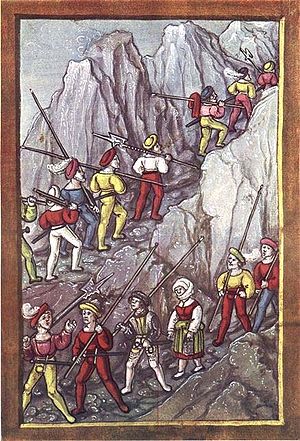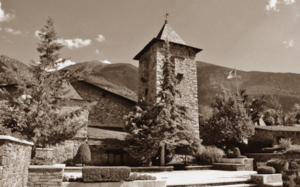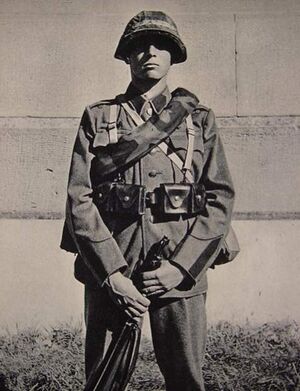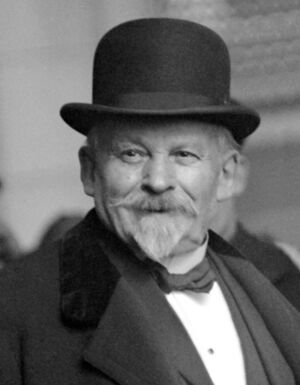Hercynia: Difference between revisions
| Line 245: | Line 245: | ||
==Culture== | ==Culture== | ||
===Art=== | ===Art=== | ||
Art in Hercynia has always aimed to make an emotional impact in the form of introspection rather than idealization as is seen in the art of nations such as Altenland or Aventium. | |||
===Architecture=== | ===Architecture=== | ||
| Line 251: | Line 252: | ||
===Education, Philosophy, and the College=== | ===Education, Philosophy, and the College=== | ||
===Food and Drink=== | |||
Due to Cydalia's agricultural limitations, most alcoholic beverages were produced at a family level or in local breweries until the Clementine period. | |||
The most common alcoholic beverages in Hercynia are beer, cider, wine, and mead, but the most popular drink in Hercynian culture is absinthe. Made from distilling anise and fennel, modern absinthe was invented in eastern Hercynia on the outskirts of Lakusdon in 1788. Eleleth Jusop, a brewer from Lakusdon and professor at a local College outpost, claimed to have been given the drink in a dream by an angel. Passing around the recipe to various families around him, and to those passing by his College outpost, the recipe soon spread throughout Hercynia, and within a few years, western and central Cybelleum. | |||
===Literature=== | ===Literature=== | ||
Revision as of 03:27, 26 July 2020
This article is incomplete because it is pending further input from participants, or it is a work-in-progress by one author. Please comment on this article's talk page to share your input, comments and questions. Note: To contribute to this article, you may need to seek help from the author(s) of this page. |
Enlightened Kingdom of Hercynia İlustra Tҕægesom Hrsinƣ-ҕėnke (Hercynian) Ilastrah Trégisom Hrsinrenki | |
|---|---|
|
Flag | |
| Motto: "Dħɐrɐkst ɐnɐdos Dæʢosæ." "Closer to God." | |
| Anthem: Dħɐrɐkst ɐnɐdos Dæʢosæ "Closer to God" | |
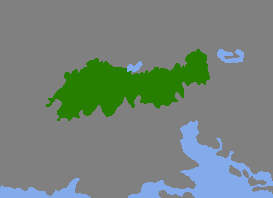 Hercynia within Cybellum. | |
| Capital and largest city | Pleroma |
| Official languages | Hercynian |
| Recognized languages | Hellian Alpanian Hellian |
| Ethnic groups | Hercynian- 89% Altish- 3% Aventines- 3% Auvernians- 1.5% Other- 3.5% |
| Religion | Hercynian Folk Religion- 45% Hercynian Catholic- 52% Other - 3% |
| Demonym(s) | Hercynian |
| Government | Absolute Monarchy |
• Tréagi | Hardin II |
| Pehushon Ribelva | |
| History | |
• First Peoples | 5,000 BC |
• Founding of the Hercynian Federation | 851 AD |
• Founding of the Kingdom of Hercynia | 959 AD |
• The Southern Rebellion | 1011 AD |
• King Garlas' Conversion | 1013 AD |
• College of Wizards Foundation | 1257 AD |
• Wars of Religion | 1290-1520 AD |
• Ninety Years' War | 1520-1610 AD |
• The Enlightenment Schism | 1682-1701 AD |
• The National Reform | 1735 AD |
• "The Opening" | 1758 AD |
• Clementine Wars | 1799-1822 AD |
• War of the Grand Coalition | 1912-1919 AD |
• Collegiate Schism | 1931 AD - |
| Population | |
• 1936 estimate | 11,450,000 |
| GDP (PPP) | estimate |
• Total | 239,178,955,020 |
| GDP (nominal) | estimate |
• Total | 23,122.5 |
| Driving side | right |
THIS PARAGRAPH IS SO I DO NOT GET FINED THIS PARAGRAPH IS SO I DO NOT GET FINED THIS PARAGRAPH IS SO I DO NOT GET FINED THIS PARAGRAPH IS SO I DO NOT GET FINED THIS PARAGRAPH IS SO I DO NOT GET FINED THIS PARAGRAPH IS SO I DO NOT GET FINED THIS PARAGRAPH IS SO I DO NOT GET FINED THIS PARAGRAPH IS SO I DO NOT GET FINED THIS PARAGRAPH IS SO I DO NOT GET FINED THIS PARAGRAPH IS SO I DO NOT GET FINED THIS PARAGRAPH IS SO I DO NOT GET FINED THIS PARAGRAPH IS SO I DO NOT GET FINED THIS PARAGRAPH IS SO I DO NOT GET FINED THIS PARAGRAPH IS SO I DO NOT GET FINED THIS PARAGRAPH IS SO I DO NOT GET FINED THIS PARAGRAPH IS SO I DO NOT GET FINED THIS PARAGRAPH IS SO I DO NOT GET FINED THIS PARAGRAPH IS SO I DO NOT GET FINED THIS PARAGRAPH IS SO I DO NOT GET FINED THIS PARAGRAPH IS SO I DO NOT GET FINED THIS PARAGRAPH IS SO I DO NOT GET FINED THIS PARAGRAPH IS SO I DO NOT GET FINED
Etymology
The modern term Hercynia derives from the ancient Cybello-Aryavar term Erkunia, or Ėrkóƣ which originally pertained to a local tract of forest in south-central Hercynia. The While the forest has been destroyed due to human civilization over the millennia, the Erkunian forest is believed by scholars to have originally covered most of mainland Cybellum.
Due to the remote and difficult to access location of most of modern day Hercynia, linguistic distancing and cut-off evolution eventually changed the term from "Erkunia" to "Herkinia," or Hrkinƣ. This is believed to have taken place by the time of the Alpanian Republics founding in 500 BC. Afterward, by the time of the founding of the Hercynian Federation in 851, the term had evolved into the modern Hercynian Hrsinƣ.
Hercynian's complex grammar leaves terminologies relating to ownership in the case of nationality as suffixes at the end of the word. The full terminology of İlustra Tҕægesom Hrsinƣ-ҕėnke, or the "Enlightened Kingdom of Hercynia," derives from the words İlustra meaning "enlightened, bright" or "vibrantly illustrated," and Tҕægesom, or "Traégi's-dominion/Traégi's home." Hrsinƣ-ҕėnke itself means "Hercynian Realm." Яėnke is roughly analogous to the Altenic "Reich," the Reynish "Realm," Alpanian "Regnum," and the Freijian "Rijk."
Hercynian, compared to other Cybello-Aryavar languages, has been classified as the least evolved out of all of them. Please see the language section for more information.
History
Like many other nations, Hercynia has a history that is both very rich and lengthy. Originally starting off as a very loose confederation of tribes, modern Hercynia can be traced back quite far, with the first inhabitants of the region coming many millennia ago.
Hercynia has existed as a state in one form or another consistently since 851 AD, when the Hercynian Confederation, a long stretching alliance of various mountain tribes and feudal holdings, was founded. Over 100 years later, the Kingdom of Hercynia, the current form of Hercynia's statehood, was founded in 959 AD.
It is important to note that, due to Hercynia's incredibly superstitious nature, that certain important aspects of Hercynian culture may be conjecture or mythology. Likewise, given Hercynia's incredibly rough terrain and the overall philosophy of it's ruling classes, Hercynian history tends to be much more inwardly focused.
Early History and Alpania
Given that the Hercynians didn't have any written script of their own, most sources on Hercynia during antiquity come from Aventine or more distant sources.
The first recorded peoples entered Hercynia millennia ago, though as of 1930 most archaeological evidence points to the first major tribal "evolution" happening around 5,000 BC, when agriculture became relatively permanent. Various tribes began to farm wheat, barley, other grains, and a few types of fruits as well. Sheep and goats were the most common form of livestock. Most of the Hercynian tribes would frequently wage war with one another over territory, resources, or people. Beginning in the 200s BCE, the Auvernian Republic began making incursions into Hercyanian territory, frequently being beaten back.
Aventium generally considered the highlands of Hercynia to be mostly impenetrable and generally not worth the effort at the time, and instead would find alternate routes of travel, generally through southern Auvernia or modern Allestag. Forts would be established in the lowlands, and would occasionally face raids. Most of the time, Aventine soldiers going into the mountains faced death, and the same applied to Hercynian raiders venturing too far downhill. Aventine documents eventually indicate a type of "uneasy truce" was established between most Aventine garrisons and their neighboring Hercynian tribesmen - Aventine influence would be limited and Hercynian raids would stop attacking Aventine garrisons.
Hercynian Federation
The Hercynian Federation began as a tribal alliance between various Hercynian tribes and minor nobles in 851 AD in an effort to combat the growing strength of the Aventine Empire in the region. Parts of the lowlands had been attacked in previous years in efforts to Christianize the Pagan population, and had gone so far as to breach into the central plateau, sacking various settlements and sending missionaries.
Two tribal chiefs, Kakarus and Petisai, established an alliance and began expanding as other tribes of various sizes joined as well, and by 853, roughly half of the tribes in the plateau, and most of the tribes in the southern regions of Hercynia had joined the Federation. Launching an attack on missions and Aventine garrisons, the Hercynians managed to push back the Aventines over the course of the next eight years, ending in 861 after the Battle of Geks. The Battle of Geks resulted in a massive failure for the Aventines, destroying four legions in under five hours as Aventine forces were trapped in a mountain pass. The first Federation then led an incursion into northern Aventine territory in 864, which was a massive failure as the unorganized Hercynian tribesmen launched a charge against Aventine forces in an open field. Seeing as both forces had inflicted massive defeats on one another, the Aventine Empire and the Hercynian Federation agreed on a "truce" through discreet channels.
After that, the Hercynian Federation entered a period of mixed political gains. Despite gaining numbers and territory through more tribes joining them, the Federation began to steadily lose power due to the loose foundation it had for rules. The Hercynian Federation continued to have a series of political ups and downs within it, separated by numerous factions based on literal tribalism and material fights. Internal strife was common, and the Federation came close to civil war multiple times.
Beginning in 933, one of the more powerful tribal chiefs, Djedjo, had consolidated power in the Plateau and began expanding his tribe's personal power in spite of the unwritten "constitution" that the Federation had.
Kingdom of Hercynia, King Garlas, and the Southern Rebellion
The College of Wizards and the Wars of Religion
Ninety Years War
Period of Reform
Clementine Period
Neutrality in the War and the Collegiate Schism
Geography
Hercynia encompasses the majority of the middle of the Viridic Mountain range, and because of the wide variety in landscapes, individual regions within Hercynia usually tend to have much variation in temperature and climate that is heavily dependent on their altitude. The majority of the country is incredibly mountainous as well, with the rest of the country generally consisting of valleys and hillscapes, though small patches of plains are more common in the far eastern and far western areas of Hercynia.
Many tall mountains exist in the center and eastern regions of Hercynia, with the largest of them being Mount Dholys, the tallest mountain in the world, at 7897 meters, or 25,909 feet. About sixty of Hercynia's mountains exist at over 4,000 meters, and another ten or so are over 5,000.
The central and western parts of the nation form the more populous Hercynian plateau, and around 45% of the total population of Hercynia resides within this area, and most of Hercynia's cities lie within this zone. Most of the lakes and rivers within Hercynia either are present or flow through this region. The largest of these lakes is Lake Khifas. The plateau features valleys, hillscapes, and pastures. Most agriculture within Hercynia is also located here. Smaller plateaus exist in the eastern regions of the nation as well.
Hercynia's lowlands are located in border regions and are sparsely populated when compared to the plateau, and are generally used for agricultural purposes and trade with neighboring nations. The lowlands are heavily fortified due to concerns about foreign military intervention.
Environment and Biomes
Climate
Climate in Hercynia varies greatly, though this is affected most by altitude. As would be expected, higher regions are generally colder and experience more snowfall while the lowlands and valleys within Hercynia are warmer and generally tend to receive a mix of rainfall and snowfall.
Politics
The Hercynian political system is ancient and antiquated, originally coming from a tribal confederation that evolved into a kingdom mirroring many others in continental Cybellum. With the founding of the Wizards' College in 1257, Hercynia's political system found itself increasingly involved with various aspects of the college, and to this day the two remain largely intertwined. Most in the Hercynian government have been some sort of educator or collegiate student in the past.
Compared to many other governments, Hercynia's government does not give much funding to the departments pertaining to foreign affairs. Instead, given it's neutral position, Hercynia's government tends to focus inwards.
Government
Political Factions
As is the case in many other nations, Hercynia's government has it's own internal factions, generally orienting themselves along the standard "reform and progress versus tradition and stability" dichotomy. However, this generally pertains more to material matters, and as such, many politicians within Hercynia generally don't disagree much, and finding compromises are easier than in more material-minded nations.
Foreign Relations
Hercynia has a complex relationship with most other nations, especially those bordering it. Having a long history of conflict with Altish, Auvernian, and Aventine states bordering it, Hercynia has generally elected to remain politically neutral as much as possible as to not incur the wrath of its neighbors. This also ends up affecting policies made in regards to the Hercynian economy and military. Since the founding of the Hercynian Kingdom and it's initial expansion, Hercynia's borders have remained largely static, only changing when foreign nations violated it's neutrality. While not a member of the Grand Coalition, Hercynia was fundamental in it's establishment, working closely with the Aventine Empire and various Lyndaist states in forming the "international forum" to avoid future conflicts. Likewise, many international organizations - including the Grand Coalition - are either headquartered inside of or have outposts inside of Hercynia's borders. Hercynia also maintains diplomatic relations with many nations due to it's mercenary expenditures, from Aestia to Tellures.
Hercynia has acted as a safehaven for many throughout history who have been exiled from their homelands, including the exiled Kaiser of Altenland, Siegfried III. Because of actions such as this, alongside mercenary expeditions, Hercynian neutrality has been questioned numerous times.
Judiciary and Law Enforcement
Judiciary in Hercynia is rather simple - courts are organized by region, with a national court pertaining to national laws. Additionally, a Collegiate Court pertaining to legal matters inside the College of Wizards, and a military court that usually deals with soldiers and the military.
Law Enforcement in Hercynia is meant to be largely even handed, and this is accomplished by having no police force, but rather repurposing various military units to temporarily function as police or gendarmerie for specific regions for a time before being rotated. This is meant to reduce corruption by having an impartial police force. Trust is established by working alongside local officials. These troops are generally referred to the locals as Miλⴽ Jeϣ or "Milts Jeerl," literally "Junior Soldiers." They work hand in hand with the Internal Security Board to ensure public safety.
Military
The military of Hercynia is rather unique compared to other Cybellian militaries. When inside the borders of Hercynia, the Hercynian military (Hercynian: Miλⴽ Hrsinƣ-ҕėnke or "Milts Hrsinrenke") functions as a primarily defensive and policing force, and it generally spends its time preforming training, civil building projects, or policing the local populace.
The military is divided up into four sections. These are the Army, or "Milts," the Internal Security Board (Hercynian: İnd𐒉 Miλⴽ Ξėrdөs, "Indja Milts Kwehrdois"), the Royal Guard (Hercynian: Tréagᐱ Ξėrdөs, "Treagew Kwehrdois"), and the Air Force (Hercynian: Por𐒉 Ξėrdөs, "Porjaa Kwehrdois"). Of these, the largest is without a doubt the general Army, which is tasked with most of domestic and foreign issues pertaining to defense. The Internal Security Board, or the IhMKw, is tasked with more domestic disputes. While they don't police the general populace like the general Army do, they work more as detectives and as heavily armed police working to weed out internal strife and internal dissidents. They commonly are dispatched in response to cases of "black magic," or rogue witches or wizards attempting to curse people. The Royal Guard, as its name would suggest, is made to protect the Royal Family and other important government and Collegiate figures. The Air Force, while small, is made to provide an initial level of defense against possible invasion.
Outside of Hercynia, soldiers from the military, commonly referred to colloquially as "Milts" generally find themselves in the service of foreign nations. Owing to a large mercenary history stretching back to before the founding of the Hercynian Federation, individual Hercynian army regiments are generally hired out by various foreign powers to preform many tasks on their behalf. These can include colonial patrols, capturing forts, counterinsurgency, assassination, and more. Owing to Hercynia's neutrality, Hercynian regiments can be hired by any nation provided that they are paid well enough for their services, and Hercynian mercenaries served in the War of the Grand Coalition on both sides. This "foreign service" is commonly referred to as Gosti Ambigat, or GosAm for short.
Hercynian soldiers are required to follow a "code of honor" when serving outside the Kingdom, in which individual regiments are required to never fire on one another, get in the way of another regiment, or overall cause disruptions that would negatively affect Hercynia on the world stage. As would be expected, this foreign service has caused numerous diplomatic incidents between Hercynia and other countries, especially Altenland, Alytaj, Auvernia, and the SIA. In recent years, foreign interventions in Nymeria and Aestia have caused the majority of these diplomatic incidents.
In the Army and Royal Guard, service is generally open only to men, though since The Opening, individual regiments have been allowed to recruit women into their ranks for the purposes of espionage, support, or frontline combat. The Air Force and IhMKw both openly recruit women into their ranks.
Demographics
Ethnic Groups and Languages
The main ethnicity within Hercynia are Hercynians, a Cybello-Ayravar group who are believed to have originated from the Velivoi steppes millennia ago. Having conquered, displaced, and intermarried with the native old Cybelleans, the Hercynians proceeded to rule over them for a time before the smaller old Cybelleans were assimilated into ancient Hercynian culture. The Hercynians comprise about 89-90% of Hercynia's total population, and they speak Hercynian as their primary language.
Apart from the ethnic Hercynians, the lowlands and border regions have small numbers of Auvernians, Aventines, and Altish peoples living within the nations, generally as farmers or urban laborers. In total, they comprise about 7-7.5% of the total population of Hercynia. Most of these peoples, with the exception of those living in the lowest lowlands right on the border, generally speak Hercynian in their day to day lives, but use their native languages at home. In recent decades, however, there have been efforts to "Hercynize" these groups, and most of these regional minorities, especially the youth, are being culturally assimilated into mainstream Hercynian culture.
Due to the College of Wizards being one of the most widely renowned educational institutions in the world, there are many foreigners from across the world who reside in Hercynia for educational purposes. In total, about 3% of the total Hercynian populace is of foreign origin at any given time. Most commonly these peoples come from Sophia, Alytaj, Volkhov, Saidokamanagar, Kefalion, the United Provinces, southeastern Tellures, and Anzulab. Hercynia maintains a relatively flexible policy on immigration, but only in relation to the Colleges. Provided they can "prove their worth," anyone from anywhere can apply to the College of Wizards. Notable foreigners include Armando Cabrerra, a noted politician, and Yohannes Tedesse Zekai, the head of the Philosophical University. While most students return home, if capable of doing so, foreigners who wish to remain in Hercynia are able to provided they assimilate into mainstream Hercynian culture and society. They are also required to serve at least 3 years of military service with the Milts, and generally work as local guides, translators, or more.
Religion
Healthcare
Healthcare in Hercynia is rather unique when compared to neighboring Cybellean nations. Generally considered to be slightly above the Cybellean standard of healthcare on the standard of technology, Hercynian healthcare is considered to be, like many other things in the nation, to have a heavy spiritualist slant. Alongside standard medical procedure, most Hercynian physicians in both urban and rural areas make heavy usage of shaman-like practices and self-hypnosis or autosuggestion to manage pain post surgery.
In addition, antibiotics such as penicillin, while new discoveries, are used in tandem with more traditional forms of medicine to treat physical trauma.
Education and the College of Wizards
Economy
Agriculture
Energy
Industry
Infrastructure
Mercenaries
Science and Technology
Transport
Culture
Art
Art in Hercynia has always aimed to make an emotional impact in the form of introspection rather than idealization as is seen in the art of nations such as Altenland or Aventium.
Architecture
Dress
Education, Philosophy, and the College
Food and Drink
Due to Cydalia's agricultural limitations, most alcoholic beverages were produced at a family level or in local breweries until the Clementine period.
The most common alcoholic beverages in Hercynia are beer, cider, wine, and mead, but the most popular drink in Hercynian culture is absinthe. Made from distilling anise and fennel, modern absinthe was invented in eastern Hercynia on the outskirts of Lakusdon in 1788. Eleleth Jusop, a brewer from Lakusdon and professor at a local College outpost, claimed to have been given the drink in a dream by an angel. Passing around the recipe to various families around him, and to those passing by his College outpost, the recipe soon spread throughout Hercynia, and within a few years, western and central Cybelleum.


